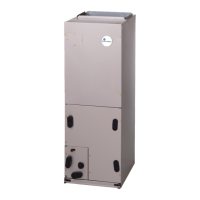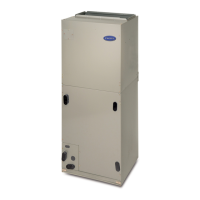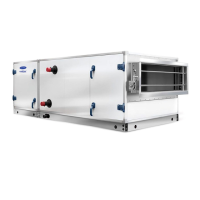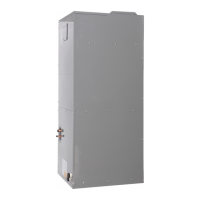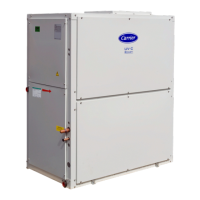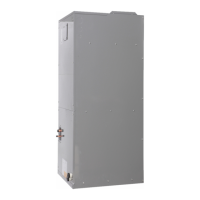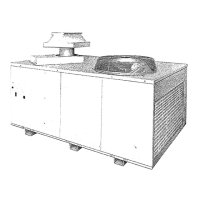92
OPERATION
For operation, PID control will be utilized. The process will run at
the rate defined by the Configuration
HUMD
H.PID
HM.TM. The first part of humidity control tests the humidity con-
trol configuration and will turn on corresponding configurations to
read space or return air relative humidity. If the supply fan has
been ON for 30 seconds and the space is occupied, then the hu-
midification is started.
Actuator Control
Control is performed with a generic PID loop where:
Error = HM.SP – humidity sensor value (SP.RH or RA.RH, de-
pending on configuration).
The PID terms are calculated as follows:
P = K * HM.P * error
I = K * HM.I * error + “I” last time through
D = K * HM.D * (error – error last time through)
Where K = HM.TM/60 to normalize the effect of changing the
run time rate.
Relay Output Control
If the humidity sensor reading is greater than the humidity set
point then the humidity relay (Outputs
GEN.O
HUM.R) is
closed. The relay will open when the humidity is 2% less than the
humidity set point.
CONFIGURING THE HUMIDIFIER ACTUATOR
Every actuator used in the P Series control system has its own
unique serial number. The rooftop control uses this serial number
to communicate with the actuator. The actuator serial number is
located on a two-part sticker affixed to the side of the actuator
housing. Remove one of the actuator’s serial number labels and
paste it onto the actuator serial number records label located inside
the left-hand access panel at the unit’s control panel. Four individ-
ual numbers make up this serial number. Program the serial num-
ber of the actuator in its Humidifier Actuator Configurations
group, ACT.C (SN.1, SN.2, SN.3, SN.4).
NOTE: The serial numbers for all actuators can be found inside
the control doors of the unit as well as on the actuator itself. If an
actuator is replaced in the field, it is a good idea to remove the ad-
ditional peel-off serial number sticker on the actuator and cover up
the old one inside the control doors.
Control Angle Alarm (Configuration
HUMD
ACTC
C.A.LM)
The humidifier actuator learns what its end stops are though a cal-
ibration at the factory. Field-installed actuators may be calibrated
in the Service Test mode. When an actuator learns its end stops
through calibration, it determines its control angle. The actuator
will resolve this control angle and express its operation in a per-
cent (%) of this learned range.
If the humidifier actuator has not learned a sufficient control angle
during calibration, the actuator will be unable to control humidity.
For this reason, the humidifier actuator has a configurable control
angle alarm low limit (C.A.LM). If the control angle learned
through calibration is less than C.A.LM, an alert will occur and the
actuator will not function.
NOTE: This configuration does not typically need adjustment. It
is configurable for the small number of jobs which may require a
custom solution or workaround.
Dehumidification and Reheat
The Dehumidification function will override comfort condition
set points based on dry bulb temperature and deliver cooler and
lower moisture content air off of the unit evaporator coil to satis-
fy a humidity set point at the space or return air humidity sensor.
The Reheat function will energize a suitable heating system con-
current with dehumidification sequence in order to raise the unit
leaving air temperature up to the Vent, Cool, or Heat supply air
temperature set point in order to not over-cool the space. The
dehumidification sequence requires the installation of a space or
return air humidity sensor or a discrete switch input. A CEM
(option or accessory) is required to accommodate an RH (rela-
tive humidity) sensor connection. Reheat is possible when multi-
ple-step staged gas or modulating gas control option or hydronic
heat (option or field-installed coil) is installed. Reheat is also
possible using a heat reclaim coil (field-supplied and installed)
or a hot gas reheat coil (special order, factory-installed). Reheat
is not possible with electric heat.
Dehumidification and reheat control are allowed during Cooling,
Heating, and Vent modes in the Occupied period.
On constant volume units using thermostat inputs (C.TYP = 3),
the discrete switch input must be used as the dehumidification
control input. The commercial Thermidistat™ device is the rec-
ommended accessory device.
SETTING UP THE SYSTEM
The settings for dehumidification can be found at the local display
at Configuration
DEHU. See Table 72.
Dehumidification Configuration (D.SEL)
The dehumidification configuration can be set for the following
settings (see Table 73):
• D.SEL = 0 — No dehumidification and reheat.
• D.SEL = 1 — The control will perform both dehumidifica-
tion and reheat with modulating valve (hydronic).
• D.SEL = 2 — The control will perform dehumidification
and reheat with staged gas only.
• D.SEL = 3 — The control will perform both dehumidifica-
tion and reheat with third-party heat via an alarm relay. In the
case of D.SEL=3, during dehumidification, the alarm relay
will close to convey the need for reheat. A typical application
might be to energize a 3-way valve to perform hot gas reheat.
• D.SEL = 4 — The control will use the Humidi-MiZer
adaptive dehumidification system.
• D.SEL = 5 — The unit will operate in dehumidification
mode (Venting Dehum, Cooling Dehum) but without any
reheat. The unit leaving air temperature will be equal to the
Dehum Cool Setpoint (DHCOOLSP) during both the Vent-
ing Dehum and Cooling Dehum modes. This may result in
over cooling of the conditioned space. With this configura-
tion, if the unit control attempts to go into Heating Dehum,
the dehumidification function will shut off and only heating
mode will be active.
Dehumidification Sensor (D.SEN)
The sensor can be configured for the following settings:
• D.SEN = 1 — Initiated by return air relative humidity sensor.
• D.SEN = 2 — Initiated by space relative humidity sensor.
• D.SEN = 3 — Initiated by discrete input.
Economizer Disable in Dehum Mode (D.EC.D)
This configuration determines economizer operation during Dehu-
midification mode.
• D.EC.D = YES — Economizer disabled during dehumidi-
fication (default).
• D.EC.D = NO — Economizer not disabled during
dehumidification.
Vent Reheat Set Point Select (D.V.CF)
This configuration determines how the vent reheat set point is se-
lected.
• D.V.CF = 0 — Reheat follows an offset subtracted from
return air temperature (D.V.RA).
• D.V.CF = 1 — Reheat follows a dehumidification heat set
point (D.V.HT).

